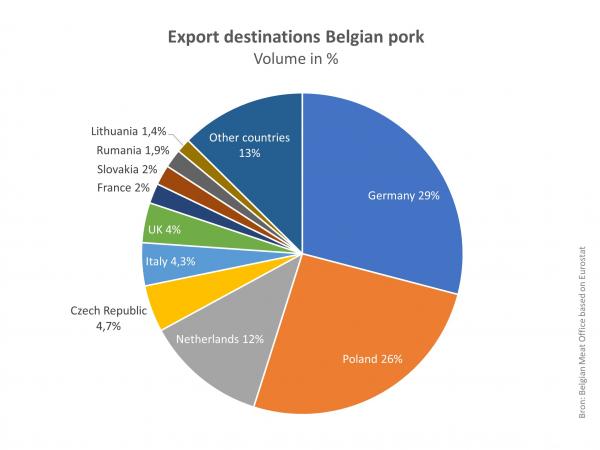In 2019 Belgium exported almost 800,000 tonnes of pork, which is 5% less than in 2018. This decrease was mainly attributable to the smaller pig population, reduced production and the outbreak of African swine fever among wild boars in Belgium. Due to a number of export embargoes major partners such as China disappeared, and Belgium focused mainly on EU countries as a result. As regards third countries, Belgium increased its exports to West and Central Africa.
Reduced production
The pig population consisted of just over six million animals in 2019, a contraction of 2% compared to 2018. In 2019 almost 11 million pigs were slaughtered in Belgium, representing a decrease of 4.55% compared to 2018. Production amounted to just over one million tonnes, with the average slaughter weight increasing from 95.5 to 96.9 kilos.
Europe: Germany remained the biggest partner
In 2019, Belgium confirmed its good relations with European trading partners. Germany remained the number-one partner with a share of 29% (224,731 tonnes), and Poland was a close second with 26%. The Netherlands ranked third with a share of 12%.

Third countries: increased exports to West and Central Africa
A number of export embargoes were applied due to African swine fever, and as a result exports of Belgian pork to third countries decreased by 41% compared to 2018. To a large extent, Belgium was able to accommodate the disappearance of a number of major partners by exporting to West and Central Africa.
For example, Belgian exports to Côte d’Ivoire, the second-largest trading partner after Hong Kong, doubled in one year (7,432 tonnes). Vietnam took third place, with 7,153 tonnes, representing an increase of no less than 209%. Exports to Congo, Ghana and Gabon also increased.
Belgium exported mainly edible by-products (64%) and cuts (29%) to third countries, including frozen deboned cuts, frozen bellies and shoulders. In addition, pork fat (7%) was also exported to third countries